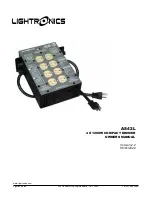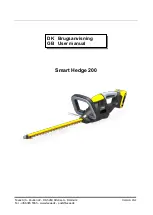
GB-3
c) Avoid unintentional operation. Make sure that
the switch is in ‘OFF’ position before pulling
the plug from the mains socket.
When carrying
the tool with your finger on the on/off switch or con
-
necting the tool to the mains supply with the switch
in ‘ON’ position, this may result in accidents.
d)
Remove adjustment tools or wrenches and the
like before you switch the tool on.
A wrench or
another tool that is inside or on a turning part of the
tool may cause injury.
e) Do not overestimate your abilities. Take care
of a safe footing and keep your balance at all
times.
This will allow you to better control the tool
in unexpected situations.
f) Wear suitable clothes. Do not wear wide cloth-
ing or jewellery. Keep your hair, clothes and
gloves clear of all moving parts.
Loose clothing,
jewellery or long hair may get caught in moving
parts.
g)
If dust extraction/collection devices are pro
-
vided make sure that they are connected and
used properly.
The use of these devices reduces
hazards caused by dust.
4) Careful handling and use of power tools
a) Do not overtax the power tool. Use the power
tool intended for your type of work in each
case.
The use of the suitable power tool within the
stated range of performance makes working more
effective and safer.
b) Do not use a power tool with a damaged switch.
A power tool that cannot be switched on or off any
more is dangerous and must be repaired.
c) Pull the mains plug out of the socket before
you adjust a tool, change accessories or put
the tool aside.
This precaution avoids the uninten-
tional start of the tool.
d) Store power tools out of the reach of children.
Do not allow persons to use the tool if they are
not familiar with the tool or these instructions.
Power tools are dangerous if used by inexperi-
enced persons.
e) Thoroughly maintain your power tool. Check
whether moving parts are working properly
and are not jamming/sticking, and whether
parts are broken or otherwise damaged in a
way that affects the function of the tool. Have
damaged parts repaired before using the tool.
Many accidents are the result of poorly maintained
power tools.
f) Keep cutting tools sharp and clean.
Thoroughly
looked-after cutting tools with sharp cutting edges
are jamming less often and are easier to guide.
g) Use power tools, accessories, add-on tools,
etc. in accordance with these instructions and
in the way prescribed for the respective type
of tool. You should also consider the working
conditions and the work to be carried out.
The
use of power tools for purposes other than those
intended for the respective tool may result in dan-
gerous situations.
5) Service
a)
Have the power tool serviced by qualified tech
-
nical personnel only; repairs should be carried
out using exclusively original spare parts.
This
will ensure the safe operation of the power tool.
Safety instructions for hedge trimmers:
-
Keep all parts of your body away from the cutting
blades. Do not try to remove cut-off matter with
the tool running. Do not try to hold material to be
cut off with your hand. Remove cut-off matter that
is stuck between the blades only with the tool be-
ing switched off!
When working with hedge trimmers
even a short moment of inattentiveness may result in
severe injury.
-
Hold the power tool by its insulated handling sur-
faces as the cutting blades might get in touch with
the tool’s own power cable.
If the cutting blades
should accidentally cut into a live power cable this
might turn metal parts of the tool ‘hot’ thereby causing
an electric shock.
-
Carry the hedge trimmer at the handle with the
cutting blades standing still. Always put on the
protection cover when transporting or storing the
hedge trimmer.
Careful handling reduces the risk of
injury through the cutting blades.
-
Keep the cable away from the cutting area.
When
working with the trimmer the cable might be hidden in
bushes and accidentally cut through.
-
The hedge trimmer should always be held with
both hands.
-
Before using the equipment clear the working
area of any foreign objects and be aware of for-
eign objects during operation of the machine!
-
Do not use the trimmer in wet weather and do
not use it to cut wet hedges.Do not wash down
the device with water. Do not use any high-
pressure cleaning devices or steam jet devices
for cleaning.
-
In line with agricultural Trade Association Regula
-
tions only persons over the age of 17 may work
on their own with electric hedge trimmers. Use is
permitted for persons over 16 years if the work is
carried out under the supervision of adults.
-
Equipment which will be used in different outside
locations should be connected via residual cur-
rent - operated current breakers.
-
For initial use of the hedge trimmer we would rec-
ommend that in addition to reading the operating
instructions, you also seek a practical demonstra-
tion from an expert.
-
Always ensure that all protective devices and
handles are properly fitted. Never attempt to use
an incomplete machine.
-
Never try to use an incomplete tool or a tool that
has been modified in a way that has not been
approved.
-
Familiarize yourself with the working area and pay
attention to possible dangers which you might not
be able to hear due to the noise of the machine.
-
Avoid to use the hedge-trimmer in poor weather
conditions, especially if there is a risk of a thun-
derstorm.
Summary of Contents for HHS 6055
Page 2: ......
Page 3: ...1 1 2 3 8 mm 20 mm 6 2...
Page 9: ......
Page 62: ...BG 3 3 a b c d e f g 4 a b c d e f g 5 a...
Page 63: ...BG 4 17 16 1 2 II VDE 0740 2 75 1 5 2 30 3 4 5...
Page 64: ...5 3 4 0 5 6 BG 5...
Page 96: ......
Page 98: ......
Page 103: ......
















































